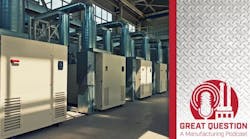Forged components for civil and military aircraft engines are among several parts being used in a research study to develop methods of combining conventional production methods with laser material deposition (LMD), to form a new manufacturing approach. “Hybrid” is a term getting a lot of use in research today, especially for material science and forming technologies. In particular, hybrid manufacturing describes how additive manufacturing pairs with other operations to apply a surface material or structure, typically using a laser-based process.
Research funded by Germany’s Federal Ministry for Education and Research (BMBF) is developing processes that combine conventional production methods with laser material deposition (LMD) for a new manufacturing approach.
“The aim was to develop an economical and robust system technology for the LMD process, based on a jointed-arm robot, and to integrate it into a process chain for hybrid manufacturing,” explained Jan Bremer, a scientist at the Fraunhofer Institute for Laser Technology ILT in Aachen. “The spectrum of content covers everything – from processing heads, robot and shielding gas systems to welding processes, quality assurance and software.”
In practice, what hybrid actually means is demonstrated by three applications from the project partners – MTU Aero Engines (adding functional elements to cast or forged engine components); Airbus (reinforcing roll-formed component structures with 3D-printed ribbing); and Mercedes-Benz (adapting die tooling for forming body panels.) The research focuses on locally reinforcing or modifying conventionally manufactured components, but the technologies are also applicable to repair process.
“These examples show what we understand by hybrid manufacturing,” Bremer said. “It is the flexible combination of advantages from different manufacturing processes, as it combines any conventional manufacturing process with LMD to form a continuous process chain.”
Hybrid manufacturing also shows how complex variant diversity can be simplified in production. “For example, you always start by punching and trimming a basic part in the same way,” Bremer explained. “Then, the variants are later produced using LMD. So, the user can continue to use his punching machine, but then additively apply reinforcements to the component, for example.
“Thanks to the LMD process and the technologies developed in ProLMD, we can act flexibly and use automation to a great extent.”
Engineers at Fraunhofer ILT and seven industrial partners are working toward an efficient, modular LMD cell that may be integrated into an existing process chain with minor effort. They are developing processes using both wire and powder as an additive material, and Fraunhofer has developed a processing optic to generate a ring beam for coaxial laser material deposition. This is being further developed and used in the ProLMD project. The optic generates a ring with a uniform intensity distribution, thus offering directional independence during welding.
In the project, processes with deposition rates in the range of 1 to 2 kg/hr. at high geometric resolution are being developed.
All this is being developed to be executed by a robot. “What speaks in its favor is its very large building space, its flexibility, and its easy accessibility,” Bremer said. “In the test facility, we can use up to eight axes to access a component of almost any complexity from all sides. The machine technology can be implemented at an amazingly low cost by means of robots.”
The project focus is on machining large, complex components. “Components weighing up to 1.2 tons and with a diameter of two meters can be processed on the robot system,” the scientist reported.
KUKA Robotics’ Lasertec business unit is responsible for project management and robotic cell integration, while Laserline GmbH is in charge of design and development of the beam source and optics. M. Braun Inertgas-Systeme GmbH is responsible for a shielding gas cell, and BCT Steuerungs- und DV-Systeme GmbH is developing software and machine-integrated measuring technology.
The research consortium also is proving it is possible to create a compact LMD cell that costs considerably less than a typical machining center. “We have scaled down the solution from a 3.1-m-long robot arm with 90-kg load capacity, to about 2 m and 60-kg load capacity,” Bremer further noted. “On the large robot, we can demonstrate a flexible changing system with wire and powder-based processing heads, while the small cell is all about powder-based LMD, machine-integrated geometry measurement and the new CAM module.”









